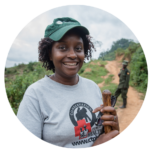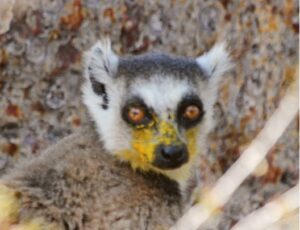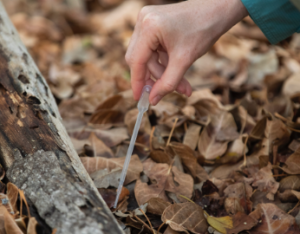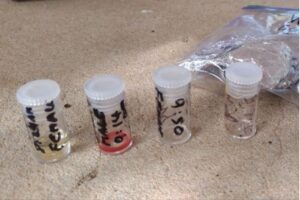Responses from Isabella Cores, Women for Conservation
Can you share an example of a particularly unique or endangered species your organization is working to protect and why it’s significant?
Our organization’s mission is to uplift women and their communities through conserving endangered species with grassroots community-led efforts. We are helping to protect hundreds of threatened animals in five countries and have highlighted a few inspiring stories in each country:
COLOMBIA | Vulnerable Yellow-eared Parrot (Ognorhynchus icterotis) and Vulnerable Quindío Wax Palm (Ceroxylon quindiuense)
Across Colombia, we partner with 12 communities to help protect dozens of endangered mammals, birds, amphibians, reptiles, and plants. More than 20 years ago, Women for Conservation’s founder Sara Inés Lara embarked on a mission to save the Yellow-eared Parrot from the brink of extinction. Women for Conservation collaborates closely with communities near three ProAves Natural Reserves dedicated to protecting this species through an annual community-based environmental education campaign to raise awareness about the Quindio Wax palm (Ceroxylon quindiuense), a crucial habitat for the parrot, which has allowed the Yellow-eared Parrot to be rescued from near extinction. Other similarly significant stories include the ongoing protections of the Critically Endangered hummingbirds Blue-bearded Helmetcrest and the Gorgeted Puffleg. Notably, in the Amazon Basin, our women’s research grants help to protect the Endangered Amazon Pink River Dolphin and the Vulnerable Yellow Spotted River Turtle, among others.
BOLIVIA | Vulnerable Andean Spectacled Bear (Tremarctos ornatus)
In Cochabamba, Bolivia, our focus is on protecting the Andean Spectacled Bear through a partnership with Programa Jucumari and coordinator Andrea Fuentes Arze. Our initiative emphasizes community-based sustainable weaving projects aimed at addressing human-wildlife conflict (HWC) due to bears roaming freely and eating the cattle of local communities. Through our collaboration with Programa Jucumari, we are actively addressing negative perceptions and retaliatory killings, utilizing ArcGIS to map bear habitats and grazing lands, and are working together with local ranchers to ensure formal protection measures. Additionally, the weaving program enhances community well-being, allowing women to earn a sustainable income and promote awareness of local biodiversity conservation.
SIERRA LEONE | Critically Endangered Western Chimpanzee (Pan troglodytes verus), Endangered Pygmy Hippo (Choeropsis liberiensis), and the Vulnerable White-necked Rockfowl (Picathartes gymnocephalus)
In Waterloo, Sierra Leone, we have supported reforestation training for 100 women so far, which has resulted in planting over 1,500 trees. We are partnered with local activist Roseline Mansary and Fridays for Future Sierra Leone to empower women with reforestation training and access to family planning education. These initiatives include reforestation campaigns, a native plant nursery, community education, and family planning clinics. Sierra Leone is among the 10% of countries most vulnerable to climate change, and deforestation exacerbates this vulnerability, leading to severe weather events, food shortages, and habitat loss for endangered wildlife. By planting weather-resilient trees and trees that provide nuts and fruit, we create crucial buffer zones to support community food abundance and protect endangered wildlife.
MADAGASCAR | Endangered Giant Baobab (Adansonia grandidieri)
In Menabe, Madagascar, we collaborate with women forest rangers from the Fanamby Association and their director Soary Randrianjafizanaka to protect and care for the Giant Baobabs in Baobab Alley. These majestic trees are endemic to Madagascar and in 2007, Baobab Alley was classified as a “Natural Monument” to aid in preserving its three species of baobab trees. Our partnership has allowed us to fund six women rangers to protect these trees and lead initiatives to reduce the threats they face. The six women rangers, who are also homemakers, include several single mothers, widows, and heads of their families. Many are also the sole breadwinners of their households due to widespread unemployment caused by drought in the Menabe region.
NEPAL | Endangered Bengal Tiger (Panthera tigris tigris), Vulnerable Greater One-horned Rhino (Rhinoceros unicornis), and the Critically Endangered Bengal Florican (Houbaropsis bengalensis)
In Nepal we partner with Shanta Buhsal and Seejan Gyawali of Birds Nepal to introduce school children to the natural wonders of Nepal’s biodiversity and inspire the next generation of conservation leaders to protect the natural world. Our program brings students on field trips into Chitwan National Park so that students become motivated to pursue careers in wildlife conservation and ecotourism. We also bring environmental education into the classroom for students to learn to plant trees, protect native plant species, and install bird nesting boxes at schools. Additionally, we support women with career training, skill-building classes, and environmental education to support financially and environmentally sustainable livelihoods
How has your partnership with Population Connection supported your programs?
Our partnership with Population Connection has truly been a success, enabling us to provide over 1,300 individuals with access to family planning across four communities in Colombia. Working closely with local women’s groups, we prioritize reaching women facing significant barriers, including those in rural and Indigenous communities. By supporting reproductive rights and accessible healthcare, we not only are able to improve health outcomes and encourage girls to stay in school, but also promote sustainable livelihoods and the well-being of communities.
Through our “Healthy Communities for Healthy Habitats” initiative, we offer women and men access to reproductive health options, promoting healthier ecosystems and communities. Our collaboration with the health provider Profamilia allows us to provide free education, resources, cancer screenings, birth control implants, tubal ligations, and vasectomies. Having access to these options empowers women and men to make informed decisions about their reproductive health and participate actively in conservation and community development efforts. The participation of men in our programs also helps challenge stigmas and taboos, and allows the burden of birth control not to fall only on the shoulders of women in their communities.
This initiative also breaks down barriers, empowering women to participate in conservation workshops, receive sustainable livelihood training, and protect fragile ecosystems in their local communities. To date, our holistic approach of conservation education, family planning, and sustainable livelihood programs has impacted the lives of 33,200 women, children, and community members in rural Colombia, equipping them with skills to become conservation leaders in their communities.
Click here to read more about our most recent family planning day in the rural town of Palmor, which is also home to the Critically Endangered hummingbird, the Blue-bearded Helmetcrest.
Click here to read more about the 46 vasectomies we have been able to fund thanks to the support of our partnership.
We always need more support to help women and men from our waitlists access family planning services and we aim to help fund access for 300 more women in rural Colombian communities by the end of the year.
What role do government policies play in your conservation efforts, and how do you work to influence these policies? Colombia, Uganda, and Madagascar have all had newly elected presidents in office—has this impacted your work at all?
Our mission is to uplift women and protect endangered wildlife through empowering women-led community-based conservation initiatives that benefit communities, wildlife, and their shared environments. We advocate for women’s rights and the rights of endangered species by collaborating with grassroots community leaders, including community councils, schools, Indigenous leaders, and local women’s groups, to name a few.
Although many family planning services are legalized in Colombia, we focus on providing access to these services for women and men in remote rural communities that lack access to reproductive services, and in many cases lack access to basic health clinics. We serve as a bridge to facilitate access to these services by partnering with local community leaders and government entities. Our Colombian non-profit partner Profamilia carries out family planning services to individuals on our waitlists including sexual education workshops, cancer screenings, birth control implants, tubal ligations, and vasectomies.
Additionally, we work closely with local government entities to establish regional parks (to read more click here and here, allowing us to further secure environmental protections for key biodiversity areas and promote species conservation.
Have you had any success stories with corporate partnerships, and how can the private sector better support forest conservation?
We were honored to collaborate with Foundation L’Oréal’s For Women in Science Festival in 2021 where our founder spoke about the importance of advocating for women’s contributions in the field of conservation. Click here to watch Sara Ines Lara’s inspiring speech about her own contributions to bringing back the formerly Critically Endangered Yellow-eared Parrot from the brink of extinction. This was a special opportunity for us to increase the visibility of our mission and increase our audience base.
We are always looking for new partnerships, including corporate collaborations, and gladly accept nominations for grants and new partnerships. Many corporations are committed to the UN’s Sustainable Development Goals (SDGs) and partner with non-profits to achieve specific targets. For example, there may be corporations that are interested in aligning with a few of our SDG Targets which include SDG 3: Good Health and Well-Being to ensure universal access to reproductive healthcare and family planning, SDG 5: Gender Equality to eliminate violence and discrimination against women, and ensure their full inclusion and leadership is valued, and SDG 15: Life on Land to ensure environmental conservation and prevent biodiversity loss.
These private-sector partnerships could provide crucial long-term financial support through grants, sponsorships, and donations, ensuring the stability and expansion of our projects in the long term. For us at Women for Conservation, partnering with corporations would help amplify our efforts to protect biodiversity, increase access to family planning for women in rural communities, and ensure the sustainability of both communities and their environments.
What is your vision for the future of rainforests, and what steps do you think are crucial to achieving this vision?
Our vision for the future of rainforests is one where both people and nature thrive in harmony, with women leading the way in sustainable development and conservation efforts. Empowering women to develop their ideas and projects within their communities is crucial, allowing them to contribute their skills and unique gifts. This empowerment fosters leadership and stewardship of the environment, while sustainable economic opportunities ensure that any development places nature at the center, promoting a balance between growth and conservation.
A balanced approach to development integrates nature as a core component, ensuring human activities revolve around preserving and enhancing natural spaces. This shift towards sustainable living and economic practices, aligned with a well-being economy, focuses on the health and prosperity of both people and the planet. Protecting the remaining critical habitats is urgent, requiring rapid and effective conservation strategies. Engaging local communities to continue being or to become guardians of their environment ensures sustainable conservation efforts rooted in local knowledge and commitment.
Influencing policy and legislation through a bottom-up approach is essential. Local communities, especially women, should have a voice in legislative processes affecting their lands and livelihoods. Advocating for policies that protect rainforests and support sustainable practices is vital, as is bringing our conservation message to governments. Embracing sustainable living and degrowth, moving away from traditional growth models, emphasizes quality of life and environmental health over economic expansion. The Ubuntu philosophy, which emphasizes interconnectedness and communal well-being, can guide our approach to conservation and development.
Our vision involves a long-term commitment to conservation, sustainability, and community empowerment, requiring continuous effort and adaptation to changing environmental and social dynamics. By focusing on these crucial steps, we can achieve a future where rainforests are protected and nurtured, women are empowered, and communities thrive in harmony with nature. This vision underscores the importance of a sustainable, inclusive, and balanced approach to development, ensuring that rainforests and their inhabitants have a bright and prosperous future.







